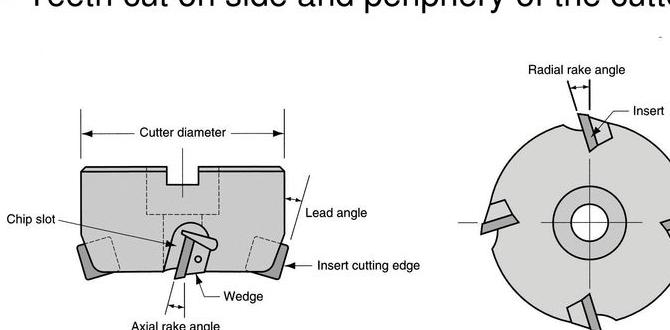1/8 Inch Carbide End Mill for Aluminum: Achieve High Material Removal Rates (MRR) Faster and Easier
Unlock impressive aluminum machining results with a 1/8-inch carbide end mill. This article guides you through selecting the right tool and optimizing settings for high Material Removal Rate (MRR), making aluminum cutting efficient and beginner-friendly. Learn proven techniques to get the most out of your small but mighty end mill.
Mastering Your 1/8 Inch Carbide End Mill for High-Speed Aluminum Cutting
Working with aluminum on your milling machine can feel daunting, especially when you’re just starting. You might have a beautiful piece of aluminum ready to be shaped, but the thought of choosing the right tool and settings for the job makes your head spin. What if the tool breaks? What if the finish is terrible? It’s a common worry, but it doesn’t have to be! The key often lies in a small but mighty tool: the 1/8-inch carbide end mill. This article is your no-nonsense guide to using this specific tool to achieve fantastic results, particularly high Material Removal Rates (MRR), in aluminum. We’ll break down everything from selecting the right end mill to setting up your machine, ensuring you feel confident and ready to cut.
Why the 1/8 Inch Carbide End Mill is Perfect for Aluminum
Aluminum is a fantastic material for hobbyists and professionals alike. It’s relatively soft, easy to machine, and widely available. However, it can also “gum up” tools if the wrong approach is taken, leading to poor finishes and tool breakage. This is precisely where a well-chosen 1/8-inch carbide end mill shines. Carbide, a super-hard material, can withstand the higher speeds and temperatures generated when cutting metals like aluminum, preventing it from dulling quickly. The small 1/8-inch (approximately 3mm) diameter is ideal for detailed work, intricate profiling, and achieving a high “chip load” relative to its size, which is essential for good MRR. We’re specifically looking at end mills designed for high MRR in aluminum, often featuring specific flute counts and geometries.
Understanding Material Removal Rate (MRR)
Before we dive into the specifics, let’s quickly touch on MRR. Material Removal Rate is simply how much volume of material you can cut per unit of time. Higher MRR means you’re removing material faster, saving you time and effort. For aluminum, achieving a good MRR with a 1/8-inch end mill involves a balance of spindle speed (RPM), feed rate, depth of cut, and stepover. It’s not just about spinning the tool fast; it’s about intelligently applying the cutting forces to remove chips efficiently without overloading the tool or the machine.
Choosing the Right 1/8 Inch Carbide End Mill for Aluminum MRR
Not all 1/8-inch carbide end mills are created equal, especially when targeting high MRR in aluminum. Here’s what to look for:
Key Features to Consider:
- Material: Always opt for Solid Carbide. While coated carbide can offer benefits in other materials, high-quality uncoated or specialized aluminum-coated carbide is often best for aluminum MRR.
- Flute Count: For aluminum MRR, 2-flute or 3-flute end mills are generally preferred.
- 2 Flutes: Offer excellent chip clearance, which is crucial for gummy materials like aluminum. This allows for faster feed rates and deeper cuts without clogging.
- 3 Flutes: Can sometimes offer a slightly better surface finish and can handle slightly higher radial engagement (stepover) than 2-flutes in certain applications. However, chip evacuation can be more critical.
- Geometry: Look for end mills with a high helix angle and a polished or bright flute finish.
- High Helix Angle: Helps to “lift” chips out of the cut more effectively, reducing re-cutting and improving chip evacuation. This is great for aluminum.
- Polished Flutes: Reduces friction and prevents aluminum chips from sticking to the cutting edges, leading to a cleaner cut and longer tool life.
- End Type:
- Square End: The most common type, suitable for general milling, pocketing, and profiling.
- Ball Nose: Creates rounded features and is often used for 3D contouring. While good for finishing, it’s not usually the first choice for maximum straight MRR in roughing.
- Shank: Ensure the shank is ground to a reliable diameter (e.g., h6 tolerance) for a secure grip in your collet or tool holder. A 1/8-inch shank is standard, but look for manufacturers that specify materials like 7075 aluminum for compatibility.
- “Aluminum” Specific: Many manufacturers offer end mills specifically designed for aluminum. These often have optimized flute geometry, coatings (like AlTiN for hardened aluminum, though sometimes uncoated polished carbide is preferred for softer alloys), and corner radii.
Example Tool Specification (Hypothetical):
When looking online, you might see descriptions like this:
“1/8″ (3.175mm) Solid Carbide End Mill, 4 Flutes, 1/8″ Shank, 1.5″ Overall Length, 0.5″ Cutting Length, High Helix, Polished Flute, Square End for Aluminum.”
For maximum MRR in soft aluminum, you might lean towards a 2-flute, high helix, polished end mill. If you’re working with harder aluminum alloys or need a balance between roughing and finishing in one tool, a 3-flute might be considered, but always prioritize chip evacuation.
Essential Cutting Parameters for Aluminum MRR
Getting the parameters right is where the magic happens. We’re aiming for efficient chip formation and removal. For a 1/8-inch carbide end mill in aluminum, consider these starting points:
Spindle Speed (RPM)
Aluminum machines well at higher speeds. A good starting point for a 1/8-inch carbide end mill is often between 12,000 and 20,000 RPM, but this can vary based on the specific end mill and the alloy of aluminum.
Feed Rate
Feed rate is critical for MRR and chip formation. It’s often expressed in inches per minute (IPM) or millimeters per minute (mm/min). The goal is to achieve an appropriate “chip load” – the thickness of the material removed by each cutting edge per revolution. For a 1/8-inch end mill, a typical chip load might range from 0.001″ to 0.003″ (0.025mm to 0.075mm).
The Formula: Feed Rate (IPM) = Spindle Speed (RPM) × Number of Flutes × Chip Load per Tooth (inches)
Calculation Example:
- Spindle Speed: 15,000 RPM
- Number of Flutes: 2
- Chip Load: 0.002 inches per tooth
- Feed Rate = 15,000 × 2 × 0.002 = 60 IPM
Depth of Cut (DOC)
For roughing operations to maximize MRR, you’ll want to take as much depth as possible without overloading the tool. A general guideline for axial depth of cut (how deep you cut into the material along the Z-axis) with a 1/8-inch end mill might be between 0.25 to 0.5 times the tool diameter. So, for a 1/8″ (0.125″) tool, this would be roughly 0.031″ to 0.062″ (0.8mm to 1.6mm).
Stepover (Radial Depth of Cut)
This is how much the end mill moves sideways (across the X or Y axis) in each pass. For efficient pocketing or contouring, a stepover of 30% to 50% of the tool diameter is common for roughing. For finishing, you’d use a much smaller stepover (e.g., 10-20%).
Cutting Strategies for High MRR
To truly maximize MRR, especially in pocketing operations, consider advanced techniques:
- Trochoidal Milling / High-Speed Machining (HSM): This involves making small, continuous, curved toolpaths instead of traditional straight plunge cuts and square corners. It maintains a consistent chip load and engagement angle, drastically reducing heat build-up and tool wear. This is where a high helix, aluminum-specific end mill truly excels. Many CAM software packages have HSM strategies readily available.
- Adaptive Clearing: Similar to trochoidal milling, this strategy uses a large radial engagement (stepover) with a controlled axial depth of cut to remove material efficiently. It automatically adjusts the path to minimize air cutting.
- Climb Milling vs. Conventional Milling: For aluminum, climb milling (where the cutter rotates in the same direction as the feed) is generally preferred. It results in less friction, a better surface finish, and puts less stress on the tool. Most modern CNC machines default to climb milling.
Setting Up Your Machine for Success
A high-quality end mill and perfect parameters are useless if your machine setup isn’t right. Here’s what to focus on:
Workholding is King
Your workpiece MUST be held securely. Any movement or vibration will lead to cutter chatter, poor finish, and potential tool breakage.
- Use robust clamps or vises. Ensure they are clean and that the workpiece is seated firmly against the clamping surfaces.
- For small parts, consider using a precision vise or fixture.
- Avoid overhanging the workpiece too far from your support point.
Rigidity and Runout
The entire cutting system needs to be rigid. This means:
- Collet Chuck/Holder: Use a high-quality collet chuck or tool holder with minimal runout (wobble). A runout of even a few thousandths of an inch can drastically affect your cut quality and tool life with a small 1/8-inch end mill. Aim for holders that provide TIR (Total Indicator Runout) of 0.0005″ or better.
- Spindle Condition: Ensure your machine’s spindle bearings are in good condition.
- Tool Length: Keep the cutting portion of the end mill extended from the tool holder as short as your geometry allows. Excessive tool stick-out leads to chatter and vibration.
Coolant/Lubrication
While some high-speed aluminum machining can be done dry with excellent chip evacuation, using a coolant or lubricant can significantly improve results, especially for deeper cuts or harder alloys.
- Flood Coolant: The traditional method, offering excellent cooling and chip flushing.
- MQL (Minimum Quantity Lubrication): Uses a fine mist of cutting fluid. This is often ideal for aluminum as it lubricates without washing away chips that can then clog.
- Lubricating Spray: Aerosol cans of cutting fluid designed for aluminum can be applied manually.
For aluminum, high-pressure coolant directed precisely at the cutting zone can be incredibly effective. It not only cools but also helps to blow chips away, enabling higher feed rates.
A great resource for understanding machining practices and fluid application can be found at the Manufacturing USA Technical Resources.
Step-by-Step: Machining Aluminum with Your 1/8 Inch End Mill
Let’s walk through a typical pocketing operation on a piece of 6061 aluminum using a 1/8-inch 2-flute, high helix, polished carbide end mill.
Step 1: Prepare Your Workpiece and Machine
- Securely mount your 6061 aluminum block in a clean vise or fixture. Ensure it’s square and won’t move.
- Clean your machine’s spindle taper and the collet holder to remove any debris.
- Insert the 1/8-inch carbide end mill into a high-quality collet chuck and tighten securely. Ensure minimal stick-out.
Step 2: Set Your Origin (Work Coordinate System)
- Use your machine’s probing system or edge finder to accurately set the X, Y, and Z zero points on your workpiece. For Z zero, it’s common to set this at the top surface of the aluminum.
Step 3: Program Your Toolpath (or Manually Set Parameters)
If using CAM software, import your design and apply an adaptive clearing or trochoidal milling strategy. For manual CNC operation or learning, manually input the following estimated parameters (adjust as needed):
- Spindle Speed: 15,000 RPM
- Feed Rate: 45-60 IPM (use the formula: 15000 RPM 2 flutes 0.0015″ chip load = 45 IPM)
- Axial Depth of Cut (Z): 0.030″ (approx. 1/4 of tool diameter)
- Radial Depth of Cut (Stepover – X/Y): 0.050″ (approx. 40% of tool diameter)
Step 4: Initiate the Cut
- If using coolant, turn it on and ensure it’s directed at the cutting zone.
- Start the spindle rotation.
- Manually jog the Z-axis down to your initial cutting depth (0.030″) above the surface of the aluminum.
- Begin the X/Y movement to start the pocketing operation.
Step 5: Monitor and Listen
This is crucial! Pay attention to the sound and vibration your machine is making.
- Ideal Sound: A consistent, light “whirring” or “hissing” sound indicates you’re cutting efficiently.
- Bad Sound: A loud “chattering,” “screeching,” or “grinding” sound means something is wrong. This could be:
- Too deep a cut (axial or radial).
- Workpiece is loose.
- Tool is dull or chipped.
- Excessive tool stick-out.
- Speed or feed rate is incorrect.
If you hear any bad sounds, stop the machine immediately and investigate. It’s better to stop and reset than to break a tool or damage your workpiece.
Step 6: Complete the Operation
Let the machine complete the pocketing operation. For a high MRR strategy, it should make relatively quick work of the material.
Step 7: Inspect Your Results
Once the operation is finished, inspect the pocket.
- Surface Finish: Should be relatively smooth, with minimal witness marks from the tool.
- Chip Evacuation: Look for well-formed chips, not fine dust or packed-in material.
- Tool Wear: Examine the end mill (if possible, after it cools down) for any signs of premature wear, chipping, or aluminum buildup on the cutting edges.
Troubleshooting Common Issues
Even with the best setup, you might encounter problems. Here’s how to fix them:
Issue: Aluminum is Gunking Up the End Mill
- Cause: Insufficient chip evacuation, too low a spindle speed, or too high a feed rate causing rubbing instead of cutting.
- Solution:
- Increase spindle speed.
- Decrease feed rate slightly to increase chip load, or adjust for better chip thinning.
- Ensure adequate coolant flow, or consider MQL/lubricating spray.
- Use an end mill with more flutes (if you were using 2 and now use 3, be careful not to overload) or a higher helix angle.
- Take shallower axial depths of cut.
Issue: Chattering or Vibration
- Cause: Lack of rigidity, excessive tool stick-out, dull tool, incorrect speeds/feeds causing harmonic resonance.
- Solution:
- Shorten tool stick-out.
- Improve workholding rigidity.
- Use a more rigid tool holder.
- Slow down spindle speed and/or feed rate.
- Try a different depth of cut or stepover.
- Ensure the end mill is sharp.
Issue: Poor Surface Finish
- Cause: Tool not sharp, excessive runout, wrong feed rate, too shallow radial depth of cut (stepover).






